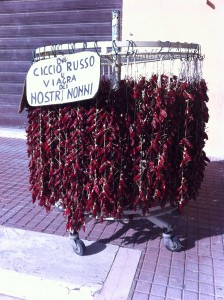
Did you know that chilli was and still is called a diavolicchio (in Puglia) or little devils? This was because some Puritans found this spice so powerful it can awaken senses and evil powers. Do you know where these little devils came from?
History has it that chilli was used as food in Mexico and Chile nine thousand years ago. It was mixed with cocoa and was taken daily. In 1514, Christopher Columbus brought the chili from the Americas to Europe, but it was Diego Alvaro Chanca, a physician, who was recorded as the first westerner to use it as a condiment.
Cultivation, Harvest and Varieties of Chilli
Chilli grows in mild climates but easily adapts even in sunny areas. Experts say that there are about 200 varieties of chilli in Italy alone and 2,000 varieties all over the world. They come in different colors and sizes. The smaller ones are known to be spicier than the bigger varieties. Harvest period is between August and September.
To assess the spiciness of each variety, the chemist Wilbur Scoville invented the SOT (Scoville Organoleptic Test) in 1912. Among the hottest chillies are: the cultivated Yucatan Habanero and Caribbean (Scoville Units: 100,000-300,000) Scotch Bonnet, grown in Jamaica, the Caribbean (Scoville Units: 100,000-250,000) the Jamaican Hot grown in Jamaica (Scoville Units: 100,000-200,000) Thai, cultivated in Southeast Asia and California (Scoville Units: 50,000-100,000) Cayenne Pepper grown in Louisiana, Mexico, Asia, Africa (Scoville Units: 30,000-50,000) on Serranocultivated in Mexico (Scoville Units: 10,000-23,000) on Wax, grown in Messsico, Calif. (Scoville Unit: 5000-10,000) Jalapeno cultivated in Mexico and South America (Scoville Units: 2500-5000) pepper grown in the Mediterranean and California (Scoville Units: 100-500).
Use of Chilli in the Kitchen
Chilli is used whole, in pieces or powder, to flavour many dishes. In Italy it is used mainly for mixing in sauces, add as toppings to pizza or chopped for garnishing. The kitchens that make greater use of chilli are the Calabrese, the region at the toe of Italy, where they use it to make spreads or chili marmellade. But the most famous product made with chilli is a spreadable sausage called “Nduja”. If you like chilli you should try it. It’s also called the natural “Viagra” that you buy in the street without prescription as you can see in the picture below 🙂

South of Italy as well as Puglia, Campania and Basilicata have some recipes where “peperoncino” is a prominent ingredient while in north of Italy it is almost absent.
Reminder:
When used in the kitchen, remember not to touch your eyes or mouth because the spiciness of the chilli can cause a stinging sensation. It is best to use gloves and wash your hands thoroughly if you are going to use this powerful spice. But this spicy quality of chilli is what makes it good for the health. It is packed with vitamins A, B, B2, D and E. If you eat or cook it fresh, you will benefit from its Vitamin C content. However, this is lost when the chilli is dried.
Health Benefits of Chilli
Chilli helps promote digestion, blood circulation, and even fertility. It is also mixed in medications for rheumatism and neuralgia. Never underestimate its power because just a couple of tablespoons is enough to cause a person to collapse or even die. This is why chilli sprays are used for self-defense.

